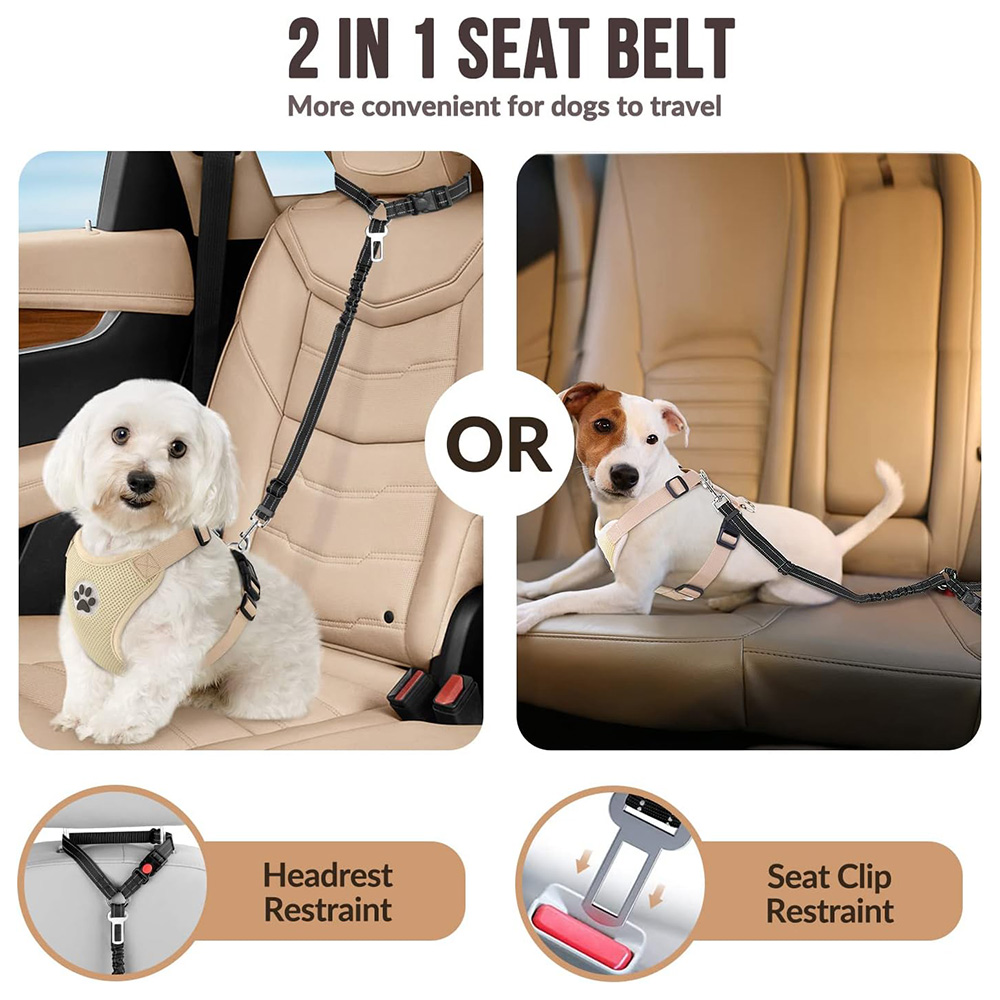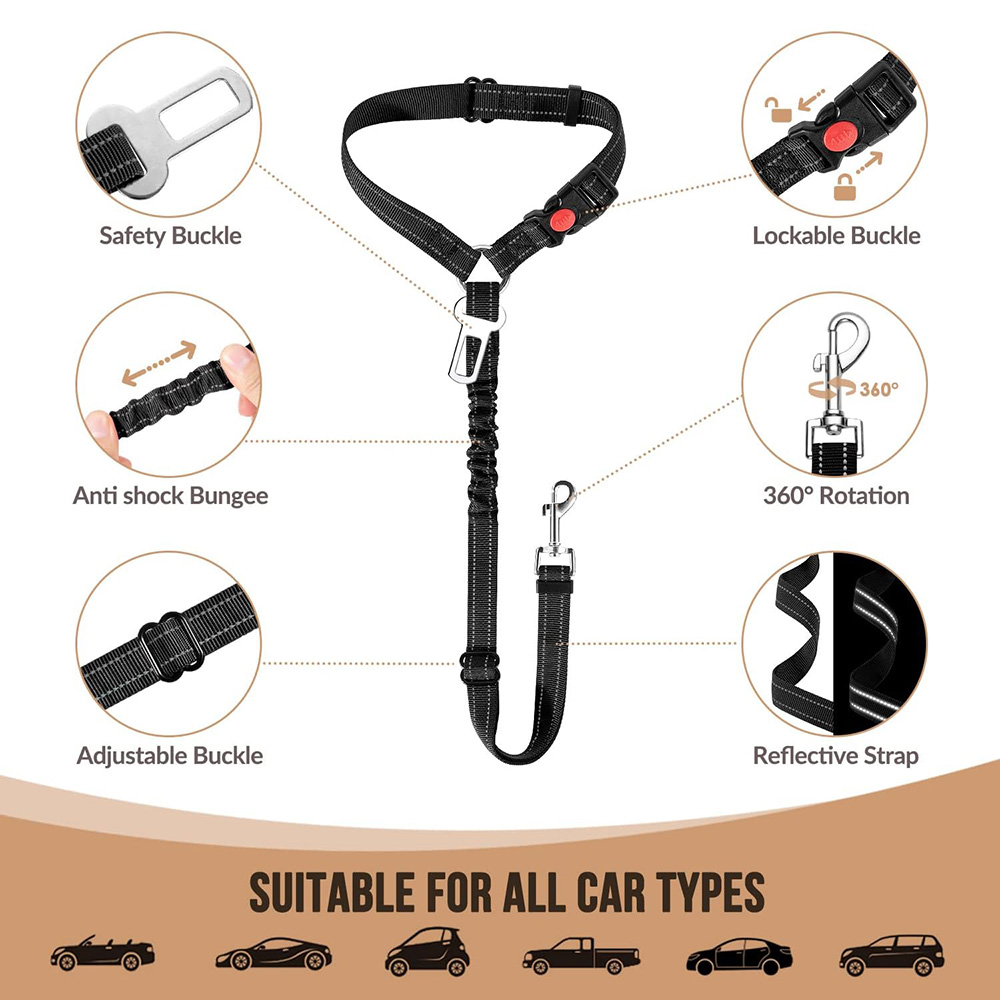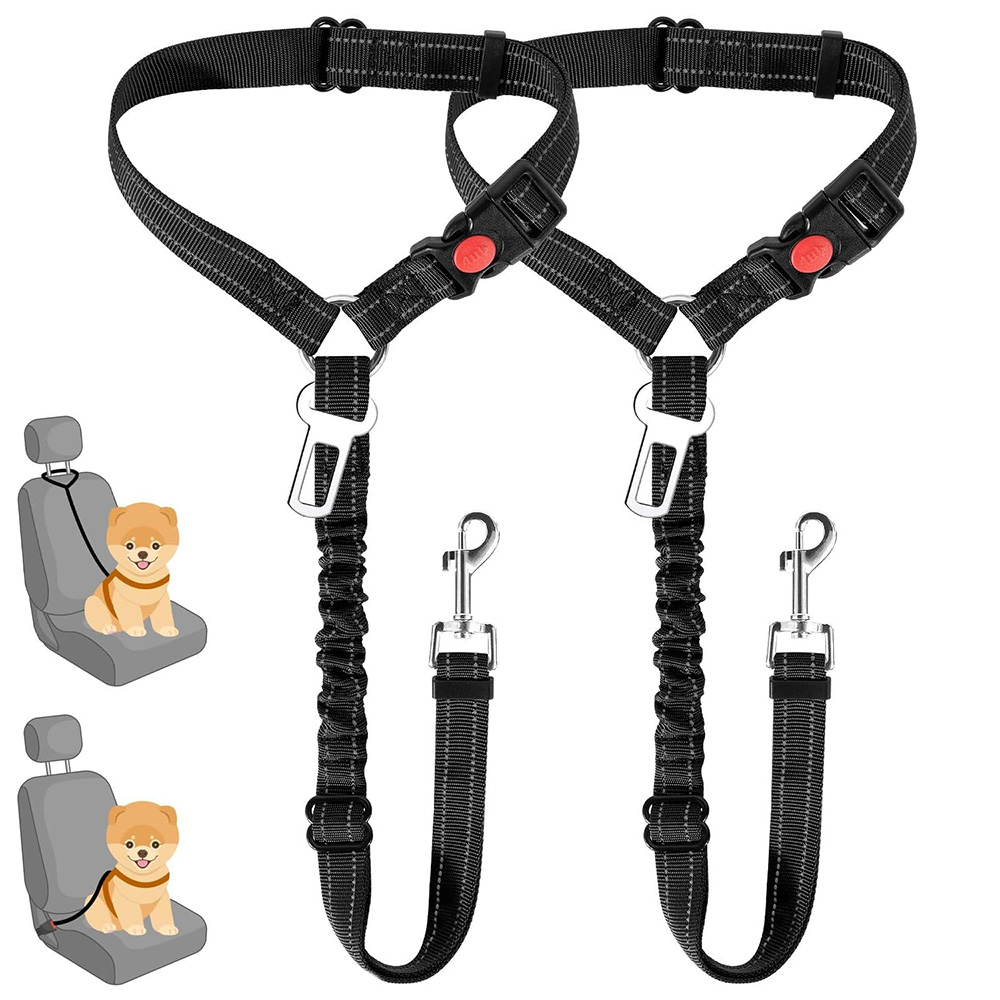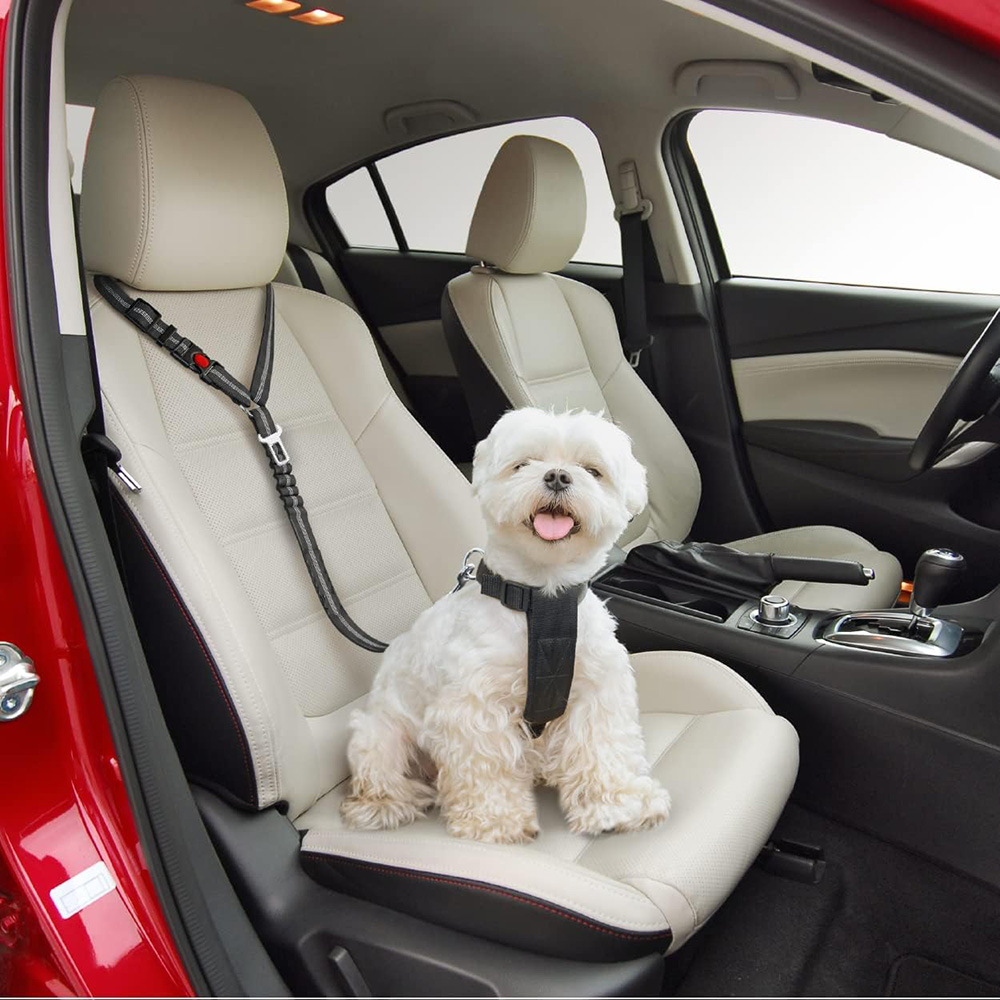Importance of Using a Car Harness for Dogs
Just like seat belts for humans, a car harness is essential for your dog’s safety. It ensures that, in case of a sudden stop or an accident, your pup doesn’t become a projectile or get injured. Additionally, a car harness can prevent your dog from becoming a distraction to the driver. It’s also worth noting that in some places, it’s legally required to secure your dog with a harness while driving.

A proper dog car harness keeps your pet safely in place. It controls movement but still allows some freedom to sit or lay down. Also, if you need to make an emergency stop or if you’re involved in an accident, a harness can help protect your furry friend from the worst of the impact. The best dog car harness will limit your dog’s ability to roam around the car, which isn’t just safe for them, but for you and any passengers as well.
While some pet owners might consider a car harness unnecessary, it’s an important tool for preventing injury. Unsecured pets can easily be ejected from a vehicle during a crash. Even at slow speeds, an accident can cause harm to an unrestrained dog. Moreover, securing your dog can also protect first responders. In an emergency situation, a frightened pet could run away or interfere with emergency workers.
In summary, the best dog car harness serves a similar purpose to a human seat belt. It keeps your pet safe and makes sure they cannot cause any unsafe situations. This leads to a more stress-free driving experience for everyone in the vehicle.
Key Features to Look for in a Dog Car Harness
When shopping for the best dog car harness, consider key features that ensure safety and comfort. Firstly, adjustability is crucial for a secure fit, regardless of your dog’s size. Harnesses that offer multiple adjustable points can provide a tailored fit. Second, durable construction is vital. Look for high-quality materials that can withstand force and wear over time. Reinforced stitching and robust metal hardware are indicators of a sturdy harness.
Comfort is another important aspect. Padding in the chest and belly areas can prevent discomfort, especially during long rides. Also, a harness allowing for a range of motion lets your pup sit or lie down without strain. The ease of use is essential for a smooth setup. Quick-release buckles make it easier to put on and remove the harness. Another feature to watch out for is reflective material. This improves visibility during night-time or low-light conditions, adding an extra layer of safety.
Moreover, a car harness should have a secure attachment point for connecting to the seat belt or a car restraint. This point should be strong enough to hold your dog in place during sudden stops. Finally, compatibility with your car may influence your choice. Ensure the harness you select works well with your vehicle’s design and seat belt system. By prioritizing these features, you’ll find a harness that provides the best protection for your furry friend.
Top Rated Dog Car Harnesses on the Market
Choosing the best dog car harness can be overwhelming with so many options available. However, there are a few that stand out due to their exceptional safety features, quality materials, and positive feedback from users. Here is a rundown of some top-rated dog car harnesses that have set the standard in the market.
Sleepypod Clickit Sport: This harness is known for its rigorous safety testing and has earned accolades for it. Its three-point design secures your dog’s entire torso. This feature can provide better protection in the event of a crash.
Ruffwear Load Up Harness: Crafted for comfort and strength, this harness is adjustable and allows for ample movement. It’s also been successfully tested in crash simulations.
Kurgo Tru-Fit Smart Harness: With its sturdy build and multiple adjustment points, this harness offers a good balance between safety and comfort. It also comes with a lifetime warranty, adding to its value.
EzyDog Drive Safety Travel Dog Car Harness: The EzyDog harness focuses on both safety and ease of use. It’s made with a durable material and simple to set up, ensuring a hassle-free experience.
Puppia Soft Dog Harness: While not as robust for car safety, this harness is lightweight and can be a good option for small, calm dogs that won’t exert too much force.
Remember to check each harness’s compatibility with your vehicle, and always ensure the correct fit for your dog. By picking from these top-rated dog car harnesses, you’re taking a vital step towards safeguarding your pet on the road.

How to Properly Fit a Dog Car Harness
Ensuring a proper fit for your dog’s car harness is critical for their safety. Start by measuring your dog’s chest girth, neck girth, and length from neck to tail. With these measurements, you can select the correct size harness. Once you have the right size, follow these steps for a proper fit.
- Adjust the Straps: Before putting the harness on your dog, loosen all straps. After placing it on your dog, adjust each strap to fit snugly. There should be no excess fabric or pinching.
- Check for Tightness: The harness should be tight enough that you can only fit two fingers under the straps. If you can fit more, it’s too loose and needs adjusting.
- Ensure Free Movement: While the harness needs to be secure, your dog should still move freely. They should be able to sit, stand, and lie down without restriction.
- Attachment to the Car: Make sure the harness attaches securely to your car’s seat belt system. Follow the manufacturer’s instructions for proper attachment.
- Double-Check Fit in the Car: Once your dog is harnessed and tethered to the car, double-check the fit. Adjust if necessary to prevent any slipping or shifting while the car is in motion.
A well-fitted harness is a cornerstone of ‘best dog car harness’ practices. It keeps your pet safe on the road and ensures the harness’s restraining features function properly in case of sudden stops or an accident. Regularly inspect the fit of the harness as well, especially if your dog’s weight changes.
Safety Tests and Certifications for Dog Car Harnesses
When picking the best dog car harness, safety is paramount. Safety tests and certifications are key indicators of a harness’s reliability. Look for harnesses that have passed rigorous crash testing done by reputable organizations. Such tests mimic real-life scenarios to ensure the harness will hold up in an accident.
Certified Products: Always check if the harness has safety certifications. Organizations like the Center for Pet Safety (CPS) provide certifications for pet products. A CPS certified harness means it has met high safety standards.
Crash Test Videos: Many manufacturers showcase their products’ safety tests through videos. Watch these crash test videos to see how the harness performs under stress.
Quality Assurance: Beyond certifications, consider a company’s commitment to quality. Reliable brands often perform additional in-house testing to guarantee consistent safety.
Product Reviews: Pay attention to customer reviews and experiences. Reviews can give insight into how the harness has performed for others in real-world situations.
By ensuring your dog’s harness has been properly tested and certified, you add an extra layer of security for your pet during car rides. Remember that the ‘best dog car harness’ not only fits well but also has proven safety credentials.
Tips for Introducing Your Dog to a Car Harness
Introducing a new car harness to your dog can seem daunting. However, with patience and the right approach, your dog will be ready for safe travels. Here are some tips to help with the introduction:
- Start Slowly: Introduce the harness to your dog in a familiar environment, like your home. Let your pup sniff and inspect it to become comfortable with the new gear.
- Associate with Positives: Connect the harness with happy times. Offer treats, playtime, or affection when your dog interacts with it.
- Practice Indoors: Before using the harness in the car, have your dog wear it around the house. This can build their comfort level.
- Take Short Trips: Begin with brief car rides. Keep trips positive with praise to build a good association with the harness.
- Use Consistent Commands: When putting the harness on and taking it off, use the same words. “Harness on” and “all done” can signal what’s expected.
- Monitor Your Dog’s Reaction: Watch for signs of stress or discomfort. If your dog seems uneasy, slow down the process. Give more time for adjustment.
- Reinforce Good Behavior: When your dog behaves well with the harness, rewards are key. Treats and kind words can reinforce that they’re doing the right thing.
- Stay Calm: Your pet can pick up on your feelings. Stay relaxed and patient during the process to keep stress levels down.
By taking these steps, you will set up your dog for success with their new car harness. Remember that some dogs may take longer to adjust than others. Always proceed at a pace comfortable for your pet. The goal is to ensure your dog associates the best dog car harness with security and positive experiences.

Maintenance and Care for Dog Car Harnesses
Maintaining your dog’s car harness is crucial for its longevity and effectiveness. Here are the steps you should take to ensure your harness remains in top condition:
- Regular Inspection: Check the harness regularly for signs of wear and tear. Look closely at straps, buckles, and attachment points. If you see any fraying or damage, replace the harness immediately.
- Cleaning Instructions: Follow the manufacturer’s guidelines for cleaning the harness. Usually, a mild soap and warm water will do the trick. Avoid harsh chemicals that can weaken the fabric.
- Proper Storage: Store the harness in a dry place when not in use. It should be kept away from direct sunlight and extreme temperatures, which can degrade the material over time.
- Avoid Modifications: Do not try to alter the harness yourself. Modifying it can compromise its safety features. Always use the harness as it is designed to be used.
- Refresh Fit Regularly: Dogs can gain or lose weight, so check the fit of the harness periodically. Adjust the straps as needed to ensure a snug fit.
A well-maintained best dog car harness can provide safety for years. Stick to a care routine, and you’ll keep your pup secure on every trip.
Common Mistakes to Avoid When Using a Dog Car Harness
When securing your dog for a car ride, avoiding common mistakes can make a big difference. Here are some errors to steer clear of with the best dog car harness:
- Incorrect Sizing: Don’t guess your dog’s size. Use a tape measure to get precise measurements before purchase.
- Not Adjusting Straps: Always adjust the harness straps to fit your dog snugly. Loose harnesses can make safety features ineffective.
- Skipping Test Drives: Take short test drives to ensure the harness fits well and your dog is comfortable traveling.
- Neglecting to Double-Check: Before every trip, double-check the harness’s fit and attachment to the seat belt.
- Ignoring Wear and Tear: Regularly inspect the harness for any signs of damage, and replace it if necessary.
- Using a Damaged Harness: A frayed or torn harness won’t protect your pet. Replace it immediately if it’s damaged.
- Forcing Your Dog: Take the time to gradually introduce the harness, making sure your dog is comfortable with it.
By keeping these tips in mind, you can ensure the safety and comfort of your dog while traveling in the car, making the best dog car harness a truly lifesaving device. Stay attentive to each detail for the best results and the safest trips.
